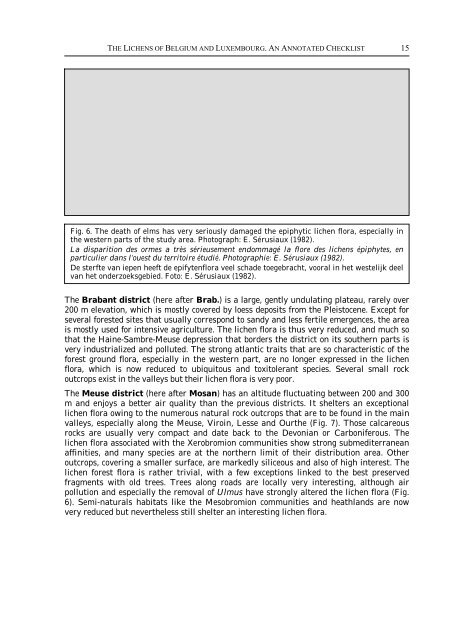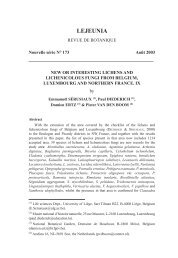The Lichens and Lichenicolous Fungi of Belgium and Luxembourg ...
The Lichens and Lichenicolous Fungi of Belgium and Luxembourg ...
The Lichens and Lichenicolous Fungi of Belgium and Luxembourg ...
You also want an ePaper? Increase the reach of your titles
YUMPU automatically turns print PDFs into web optimized ePapers that Google loves.
THE LICHENS OF BELGIUM AND LUXEMBOURG. AN ANNOTATED CHECKLIST 15<br />
Fig. 6. <strong>The</strong> death <strong>of</strong> elms has very seriously damaged the epiphytic lichen flora, especially in<br />
the western parts <strong>of</strong> the study area. Photograph: E. Sérusiaux (1982).<br />
La disparition des ormes a très sérieusement endommagé la flore des lichens épiphytes, en<br />
particulier dans l’ouest du territoire étudié. Photographie: E. Sérusiaux (1982).<br />
De sterfte van iepen heeft de epifytenflora veel schade toegebracht, vooral in het westelijk deel<br />
van het onderzoeksgebied. Foto: E. Sérusiaux (1982).<br />
<strong>The</strong> Brabant district (here after Brab.) is a large, gently undulating plateau, rarely over<br />
200 m elevation, which is mostly covered by loess deposits from the Pleistocene. Except for<br />
several forested sites that usually correspond to s<strong>and</strong>y <strong>and</strong> less fertile emergences, the area<br />
is mostly used for intensive agriculture. <strong>The</strong> lichen flora is thus very reduced, <strong>and</strong> much so<br />
that the Haine-Sambre-Meuse depression that borders the district on its southern parts is<br />
very industrialized <strong>and</strong> polluted. <strong>The</strong> strong atlantic traits that are so characteristic <strong>of</strong> the<br />
forest ground flora, especially in the western part, are no longer expressed in the lichen<br />
flora, which is now reduced to ubiquitous <strong>and</strong> toxitolerant species. Several small rock<br />
outcrops exist in the valleys but their lichen flora is very poor.<br />
<strong>The</strong> Meuse district (here after Mosan) has an altitude fluctuating between 200 <strong>and</strong> 300<br />
m <strong>and</strong> enjoys a better air quality than the previous districts. It shelters an exceptional<br />
lichen flora owing to the numerous natural rock outcrops that are to be found in the main<br />
valleys, especially along the Meuse, Viroin, Lesse <strong>and</strong> Ourthe (Fig. 7). Those calcareous<br />
rocks are usually very compact <strong>and</strong> date back to the Devonian or Carboniferous. <strong>The</strong><br />
lichen flora associated with the Xerobromion communities show strong submediterranean<br />
affinities, <strong>and</strong> many species are at the northern limit <strong>of</strong> their distribution area. Other<br />
outcrops, covering a smaller surface, are markedly siliceous <strong>and</strong> also <strong>of</strong> high interest. <strong>The</strong><br />
lichen forest flora is rather trivial, with a few exceptions linked to the best preserved<br />
fragments with old trees. Trees along roads are locally very interesting, although air<br />
pollution <strong>and</strong> especially the removal <strong>of</strong> Ulmus have strongly altered the lichen flora (Fig.<br />
6). Semi-naturals habitats like the Mesobromion communities <strong>and</strong> heathl<strong>and</strong>s are now<br />
very reduced but nevertheless still shelter an interesting lichen flora.





